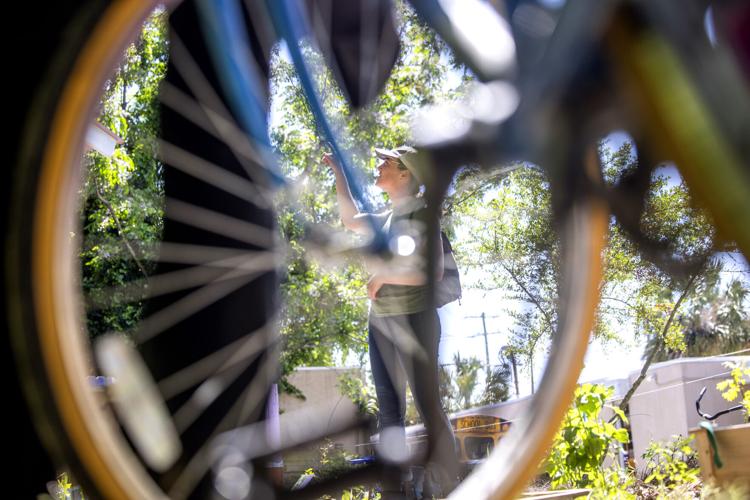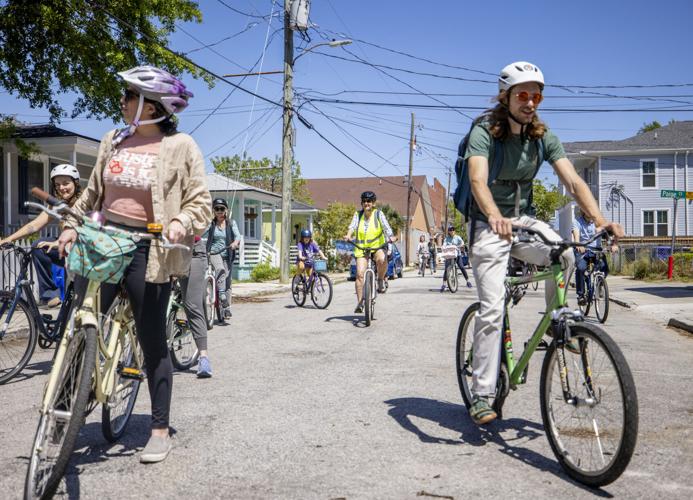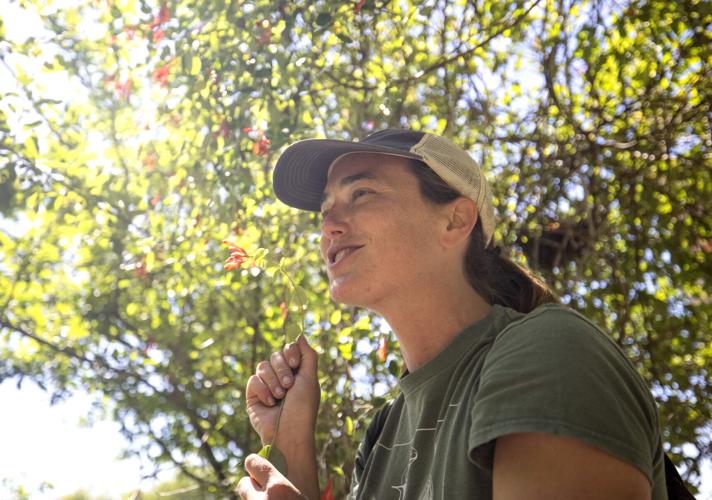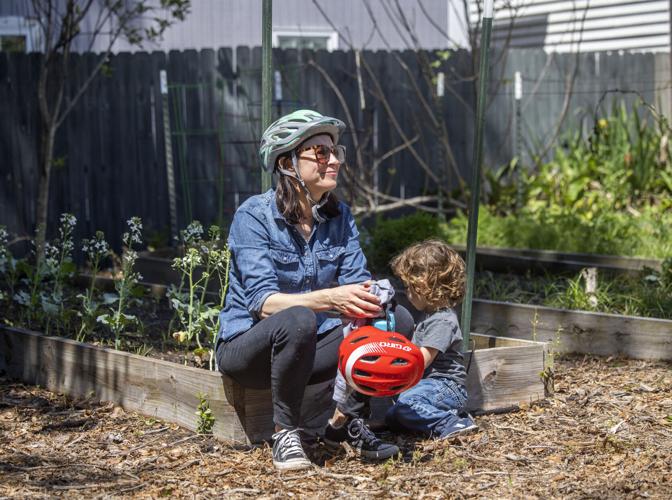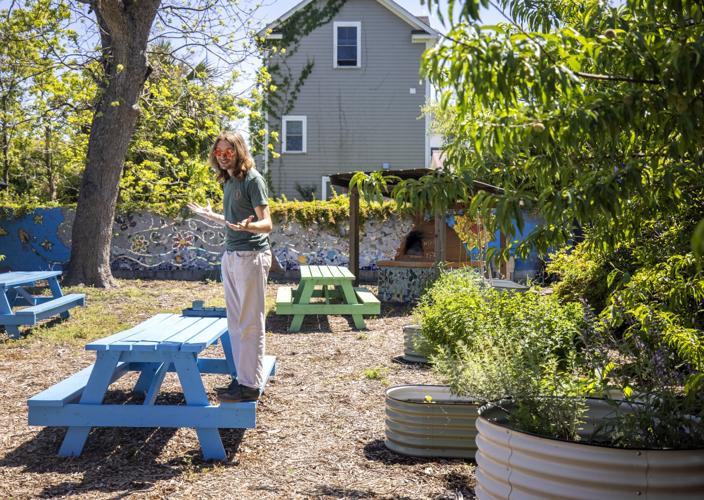It was a perfect spring day. The weather was warm but not hot. Birds chirped in the trees overhead. Recent storms had washed away much of the pollen that plagued residents for weeks.
People rolled atop their bikes into Hampton Park. Old friends caught up; newcomers introduced themselves. Some fiddled with their helmets, and others tested out loaner bikes. An offering of sunscreen appeared on a bench. Someone announced they had snacks to share.
The crowd was pumped.
Belvin Olasov, director of the Charleston Climate Coalition, climbed onto the bleachers to get everyone’s attention and kick off the group's fifth annual Tour De Earth bike ride on April 13. They would be visiting sites across the peninsula and meeting leaders of other local environmental organizations to learn about their work. The pace would be a leisurely, he assured the cyclists.
“Without further ado, let’s tour!” he said, eliciting a series of cheers and whoops from the group.

Bicyclists ride up to Romney Urban Garden on the next stop during an Earth Day bike tour, Sunday, April 13, 2025, in Charleston.
The enthusiasm for the ride belied deep anxiety. Many participants expressed concerns about the impacts of climate events on a city positioned so close to the ocean. Every time the city floods or a hurricane barrels towards the coast, those concerns grow, they said.
"Climate anxiety" refers to the distress caused by climate change, related events — such as sea-level rise and the increased risk of extreme weather and heat — and imagined future disasters. It's a relatively new term and a growing area of focus among mental health professionals.
A survey conducted in 2024 found that 63 percent of respondents in the U.S. were worried about climate change. The same survey, conducted by the University of Santa Barbara, Utah State University and the Yale Program on Climate Change Communication, also found that the majority of respondents believed climate change already is harming people, plants and wildlife and will harm future generations.
Young people, and others who are exposed to information about the climate crisis such as scientists, first-responders and activists, may feel the effects of climate anxiety more often. A 2021 study by The Lancet Planetary Health revealed that 84 percent of young people across the globe aged 16 to 25 years old are at least moderately worried about the climate, and more than half described emotions such as “sadness, anxiety, anger, powerlessness, helplessness and guilt."
Climate psychologists view these emotions as a "heathy response" to real ecological threats, according to the Climate Psychology Alliance's handbook.
"Paying heed to what is happening in our communities and across the globe is a healthier response than turning away in denial or disavowal," the alliance wrote.
But the weight of it all — the uncertainty and the sense that time is running out — may feel overwhelming to those paying attention to a changing world, it added.
South Carolina residents experience the effects of climate change first-hand with increased flooding, less predictable storms and heat waves already impacting the state.
Dorneisha Batson, a Beaufort-based artist and fashion designer, said she's concerned about more frequent, less predictable storms. She worries that population growth will corrode the marshes and strip away the trees that offers communities protection from wind and flooding. She recalled watching the Dr. Suess movie "The Lorax" with her daughter.
"We're always like, the Lorax needs to visit these people," she said. "Stop cutting down the trees, it's hurting us."
Some people cope by channeling climate-related stress into action. Finding community and holding onto hope are essential, they say.
Mindsets
For Meghan Lord, events like the coalition's bike tour offer a lifeline.

Joel Caldwell with The M.A.R.S.H. Project discuss the organization’s mission in front of Halsey Creek during an Earth Day bike tour, Sunday, April 13, 2025, in Charleston. Caldwell is hoping to build an ecological corridor between Newmarket Creek, Halsey Creek and Gadsden Creek.
“Being able to be outside, soak up vitamin D (and) get exercise, while hearing about all the incredible things that’s being done in the community just completely brightens me up and is uplifting,” she said.
Lord will graduate from the College of Charleston this spring with degrees in psychology and environmental sustainability. She’s worked hard to develop ways to cope with the stresses that can come with staying engaged in environmental work, she said.
Lord makes a distinction between climate anxiety and climate despair: Despair is rooted in sadness, while anxiety is rooted in fear, she said.
“For me, there’s less hopelessness in anxiety because it feels like there’s still room for solutions,” she said.
Despair, instead, is debilitating. It can devolve into the feeling that it’s too late to slow the climate crisis, Olasov said.
“The future is unwritten,” he said. “There can be that feeling of inevitability when you see bad news about the climate, but we truly do not know the future.”
When Lord hears bad news, she finds solace in gardening and volunteering with local organizations. Doing something, however small, helps, she said.
Agency is important in making people feel healthy and hopeful, said Abigail Harmon, a Charleston-based mental health therapist and owner of Labyrinth Counseling, a private practice.
People can control where they spend their money and who they spend their time with, Harmon said. Local action, such as participating in a beach cleanup, can go a long way, she said.
“When you go to sleep that night you are capable of thinking to yourself, ‘I can’t hold this entire world in my hands, but I demonstrably made sure that the animals and the ecosystem that is thriving in that section of the beach didn’t have to contend with the litter that I picked up today,’” she said. “And that’s good.”
For Charlton Brownell, the coalition’s environmental justice project manager, taking action helps him stay focused on what’s within his control.
“Being involved in local action is a place where you actually can make a difference,” Brownell said. “There’s a lot of overlap in your interests with people you live close to that can transcend political divides.”
One example of an overlapping interest in Charleston is flooding, Lord said.
Charleston Harbor hit a flood stage 54 times in 2024, making it one of the most active years in the last century, The Post and Courier previously reported. Sea levels around South Carolina are rising faster than globally, attributed to hotter oceans, sinking land and melting glaciers.
“People have noticed it floods more now than it used to,” Lord said. “They might not connect that with climate change, but they’re still dealing with the same emotional distress that comes with that.”

Rebecca Fanning explains how to replant a coral honeysuckle at Poinsett Street Garden during an Earth Day bike tour, Sunday, April 13, 2025, in Charleston.
Acceptance of change — not to be confused with complacency — is important to Rebecca Fanning, a local naturalist. Fanning has no intention to leave Charleston. She feels a responsibility to steward the land and share her knowledge of native plants and trees with others. But to call the Holy City home requires accepting hard truths, she said.
“The marsh will migrate no matter what, and we're going to have to get used to allowing that to happen,” she said. “I've just swallowed that hard pill of recognizing that the building footprints we have today will not be able to be the building footprints of tomorrow. It’s a really tough thing to be open and honest about.”
Hope and despair are two sides of the same coin, Harmon said. Given the massive scale of the climate crisis, it’s normal to swing between the two, she added.
Finding a ‘home’
Olasov looks forward to the coalition’s bike tour every year. It’s restorative to connect people across the city who are already engaged and who want to become more involved, he said.
The group of roughly 30 cyclists met Blake Scott and Joel Caldwell at Halsey Creek to learn about The M.A.R.S.H. Project and the effort to connect the city’s remaining tidal creeks. They rode past Corrine Jones Park to learn about the city of Charleston’s composting program and Romney Urban Garden to learn about upcoming climate events. Brownell led the group through the site of the future Lowcountry Lowline, which will connect parts of the peninsula.

Halsey Creek is one of the stops during an Earth Day bike tour, Sunday, April 13, 2025, in Charleston. The M.A.R.S.H. Project is hoping to build an ecological corridor between Newmarket Creek, Halsey Creek and Gadsden Creek.
At the butterfly book nook on Poinsett Street, Fanning talked about the benefits of native plants and trees for local pollinators and flood mitigation. The cyclists met with Kimberly Perrineau-Jackson at Enston Homes to learn about the Green Heart Project, which brings community gardens to local schools. They went to the St. Julian Devine Center to learn about the Lowcountry Action Committee.
Lin Jay with the Charleston Area Justice Ministries and Roland Flowers with Friends of Gadsden Creek met the cyclists near Harmon Field to talk about the controversial effort to save Gadsden Creek.

Coral honeysuckle is illuminated by sunlight as it blooms inside Poinsett Street Garden, Sunday, April 13, 2025, in Charleston.
Each of these organizations, including the Charleston Climate Coalition, represent a potential “political home” for people in Charleston who want to get involved, Olasov said.
Lord recalled going to litter cleanups and other events by herself when she first moved to Charleston. By showing up, she built relationships and found a community she can lean on.
Taking action isn’t just about “healing the world,” Lord said. It’s also about finding joy in working with others toward a shared goal. This, she said, is what ultimately gives her hope.

